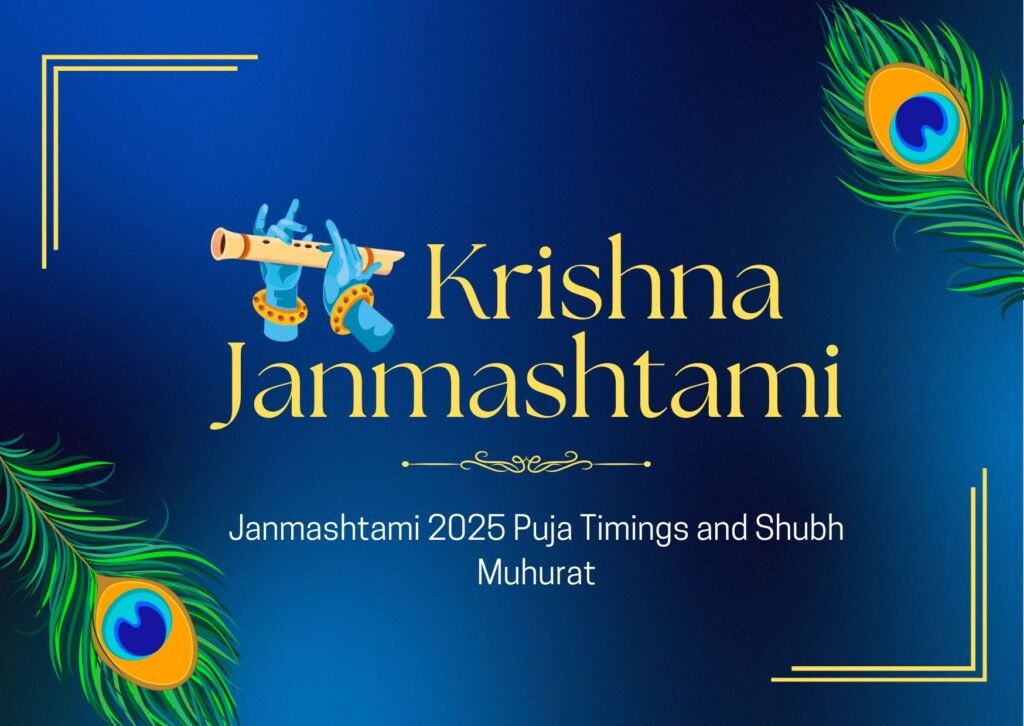Janmashtami 2025 is one of the most significant Hindu festivals, celebrated with immense devotion to mark the birth of Lord Krishna, the eighth avatar of Lord Vishnu. Known by various names such as Krishna Janmashtami, Gokulashtami, Srikrishna Jayanti, Ashtami Rohini, and Sree Jayanthi, the occasion brings together millions of devotees across India and abroad in joyous festivities. From fasting and midnight prayers to traditional music, dance, and rituals, Janmashtami is a vibrant reminder of faith, love, and devotion.

Significance of Janmashtami
Janmashtami commemorates the divine birth of Lord Krishna in Mathura, who is revered as a symbol of righteousness, compassion, and wisdom. According to Hindu scriptures, Krishna was born to Devaki and Vasudeva to free the world from the tyranny of King Kansa. His life and teachings, as depicted in the Bhagavad Gita and other sacred texts, continue to inspire generations. The festival is a way for devotees to connect with his values, spread joy, and seek blessings for peace, prosperity, and protection from evil.
Janmashtami 2025 Date and Tithi Details
According to the Hindu lunar calendar, Janmashtami falls on the Ashtami Tithi of Krishna Paksha in the month of Bhadrapada.
| Event | Date & Time |
|---|---|
| Ashtami Tithi Begins | 15 August 2025 at 11:49 PM |
| Ashtami Tithi Ends | 16 August 2025 at 09:34 PM |
Different Observances by Traditions
- 15 August 2025 (Friday Night) – Celebrated by Smarta Sampradaya, which follows Rohini Nakshatra-based observance.
- 16 August 2025 (Saturday) – Observed by Vaishnav Sampradaya, following Udaya Tithi at sunrise.
This split observance means Janmashtami will be celebrated on both days by different communities across India.
Janmashtami 2025 Puja Timings and Shubh Muhurat
The puja rituals are performed at specific auspicious times to honour the birth of Lord Krishna.
| Muhurat | Date & Time |
|---|---|
| Nishita Puja Muhurat | 16 August, 12:04 AM – 12:47 AM |
| Brahma Muhurta | 16 August, 04:24 AM – 05:07 AM |
| Vijay Muhurat | 16 August, 02:37 PM – 03:30 PM |
| Twilight Time (Godhuli Bela) | 16 August, 07:00 PM – 07:22 PM |
Nishita Kaal, the midnight hour, is considered the most sacred moment as it signifies the divine time of Krishna’s birth.
Traditional Janmashtami Rituals
Devotees immerse themselves in a variety of rituals that bring communities together and strengthen spiritual bonds.
1. Fasting (Vrat)
Many devotees observe a nirjala fast (without water) or a phalahar fast (consuming only fruits and milk) until midnight, breaking it after the puja.
2. Midnight Celebrations
Since Krishna was born at midnight, devotees perform the Nishita Puja, offering maakhan (white butter), milk, curd, and sweets like panjiri to the deity.
3. Temple Decorations
Temples and homes are beautifully adorned with flowers, lights, and jhankis (tableaus) depicting scenes from Krishna’s life, especially his childhood in Gokul and Vrindavan.
4. Chanting and Kirtan
Devotional songs, bhajans, and Hare Krishna kirtans echo throughout the night, creating an atmosphere of divine bliss.
Special Cultural Traditions Across India
Dahi Handi in Maharashtra
In states like Maharashtra, the Dahi Handi festival is a highlight. Teams form human pyramids to break a pot filled with butter, curd, and milk hung high above the ground — symbolising Krishna’s love for dairy treats.
Raas Leela in Vrindavan and Mathura
The birthplace and childhood home of Krishna celebrate with Raas Leela performances, depicting his playful interactions with the Gopis.
Jhulan Utsav
In some regions, idols of Krishna are placed in beautifully decorated swings, signifying joy and abundance.
Janmashtami Puja Vidhi (Step-by-Step)
A well-prepared puja vidhi ensures the spiritual sanctity of the festival:
- Clean and Purify the puja area.
- Place the idol or picture of Baby Krishna on a decorated swing or cradle.
- Light a diya and incense sticks.
- Offer panchamrit (a mixture of milk, curd, honey, sugar, and ghee).
- Decorate the idol with new clothes and ornaments.
- Recite Krishna mantras and read passages from the Bhagavad Gita.
- At midnight, symbolically bathe the idol with milk and water.
- Distribute prasadam to family members and devotees.
Foods Prepared During Janmashtami
Fasting during Janmashtami is often accompanied by preparing traditional satvik dishes. Common offerings and prasadam include:
- Maakhan Misri – White butter with sugar crystals.
- Panjiri – A dry sweet made with wheat flour, sugar, and ghee.
- Kheer – A creamy rice pudding with nuts.
- Sabudana Khichdi – Tapioca pearls cooked with peanuts and mild spices.
- Fruit Platters – Fresh seasonal fruits for phalahar fasts.
Janmashtami 2025 – Do’s and Don’ts
| Do’s | Don’ts |
|---|---|
| Observe the fast with devotion | Avoid tamasic foods like onion, garlic, and meat |
| Decorate Krishna idols beautifully | Don’t break the fast before midnight puja |
| Chant mantras like “Om Namo Bhagavate Vasudevaya” | Avoid alcohol or negative behaviour |
| Participate in kirtans and bhajans | Don’t waste food offered as prasadam |
Why Janmashtami is Celebrated on Two Days in 2025
In 2025, Janmashtami falls across 15–16 August, leading to two different observances:
- Smarta Sampradaya (15 August) – Celebrates based on the Rohini Nakshatra falling within Ashtami Tithi.
- Vaishnav Sampradaya (16 August) – Follows the Udaya Tithi system, placing the main celebrations on the second day.
This variation ensures that both interpretations of scriptures are honoured by different sects.
Conclusion
Janmashtami 2025 is not just a festival but a spiritual journey that brings communities together in devotion, love, and joy. Whether you observe it on 15 August or 16 August, the essence remains the same — celebrating the birth of Lord Krishna and imbibing his teachings of righteousness, compassion, and selfless love. From Nishita Kaal puja to Dahi Handi festivities, Janmashtami is a time to reconnect with tradition, celebrate cultural heritage, and seek divine blessings for a harmonious life.

Leave a Reply